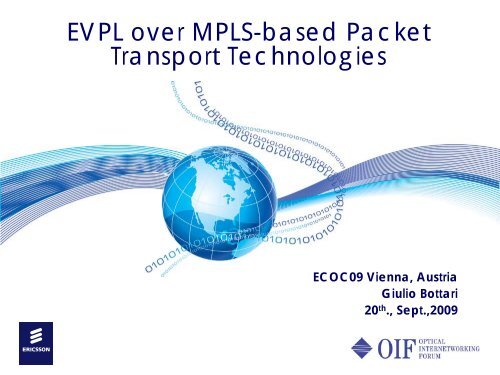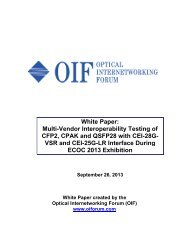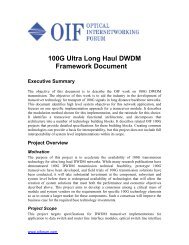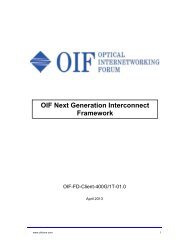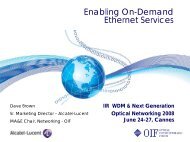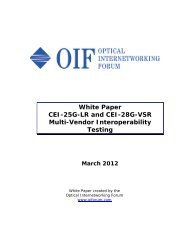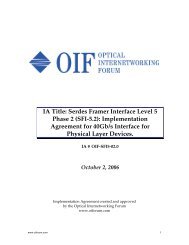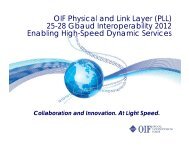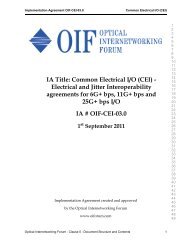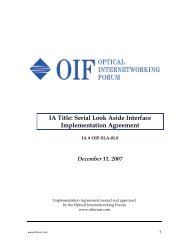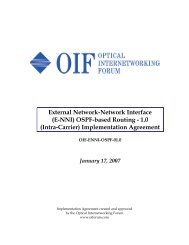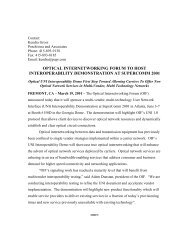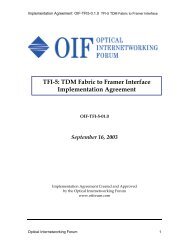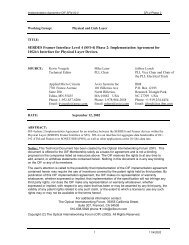EVPL over MPLS-based Packet Transport Technologies - OIF
EVPL over MPLS-based Packet Transport Technologies - OIF
EVPL over MPLS-based Packet Transport Technologies - OIF
Create successful ePaper yourself
Turn your PDF publications into a flip-book with our unique Google optimized e-Paper software.
<strong>EVPL</strong> <strong>over</strong> <strong>MPLS</strong>-<strong>based</strong> <strong>Packet</strong><br />
<strong>Transport</strong> <strong>Technologies</strong><br />
ECOC09 Vienna, Austria<br />
Giulio Bottari<br />
20 th ., Sept.,2009
Topics<br />
<br />
<br />
<br />
<br />
Ethernet Services<br />
Types of <strong>Transport</strong> Technology<br />
<strong>EVPL</strong>o<strong>MPLS</strong>-TP<br />
Benefits
Ethernet Services<br />
<br />
<br />
<br />
Ethernet Private Line (EPL)<br />
• defined by ITU-T Recommendation G.8011.1<br />
• is a point-to-point service between two demarcation points. The<br />
whole port is switched across a provider network<br />
• provided <strong>over</strong> connection oriented server layer<br />
Ethernet Virtual Private Line (<strong>EVPL</strong>)<br />
• defined by ITU-T Recommendation G.8011.2<br />
• is a point-to-point service between two demarcation points; sets of<br />
VLANS are switched to multiple destinations<br />
• provided <strong>over</strong> connection oriented or connectionless server layer<br />
Ethernet Virtual Private LAN (<strong>EVPL</strong>AN)<br />
• defined by ITU-T Recommendation G.8011.3,<br />
• is a multipoint-to-multipoint service between two or more<br />
demarcation points<br />
• provided <strong>over</strong> connection oriented server layer
Ethernet Services<br />
EPL/<strong>EVPL</strong><br />
The 2009 <strong>OIF</strong> Worldwide Interoperability Demonstration focused<br />
on a reliable end-to-end Ethernet connectivity and<br />
interoperability of on-demand Ethernet Services that are defined<br />
in the <strong>EVPL</strong> models.<br />
Ethernet Private Line (EPL)<br />
Ethernet<br />
Client<br />
Ethernet Virtual Private Line (<strong>EVPL</strong>)<br />
Ethernet<br />
Client<br />
Ethernet<br />
Client
Types of <strong>Transport</strong> Technology<br />
<strong>MPLS</strong>-TP<br />
• SDH/SONET<br />
- Physical links : STM16, STM-64, STM-256<br />
• OTN<br />
- Physical Links : OTU-1, OTU-2, OTU-3, OTU-4<br />
• <strong>MPLS</strong>-TP<br />
• PBB-TE<br />
<strong>MPLS</strong>-TP combines the advantages of both connection-oriented and<br />
connectionless technologies, achieving the target of a reliable,<br />
predictable, service aware and fully manageable, traffic<br />
engineered packet switched network.<br />
For <strong>Packet</strong> <strong>Transport</strong> Technology <strong>MPLS</strong>-TP fulfils the requirements for<br />
the transport of Ethernet services, in terms of – QoS, Reliability, OAM
Types of <strong>Transport</strong> Technology<br />
<strong>MPLS</strong>-TP through PW technology<br />
<strong>EVPL</strong><br />
PW<br />
emulation<br />
<strong>MPLS</strong>-TP<br />
PW<br />
emulation<br />
What is a “Pseudo Wire” ?<br />
• A mechanism to emulate the essential attributes of a service<br />
• Required to carry non-IP traffic <strong>over</strong> a packet-switched network<br />
Ethernet encapsulation <strong>over</strong> PW is defined in RFC 4448<br />
<br />
Ethernet PW allows for the transport <strong>over</strong> <strong>MPLS</strong>-TP <strong>based</strong> Networks
<strong>EVPL</strong>o<strong>MPLS</strong>-TP<br />
Equipment/technology Demonstrated<br />
•Ericsson demonstrated the ability to set-up BoD (Bandwidth on<br />
Demand) connections across multi-vendor, multi-technology<br />
and multi-carrier domains in a truly global network.<br />
The first multi-vendor interoperability test of <strong>MPLS</strong>-TP pre-standard<br />
implementation was shown<br />
Europe USA Asia<br />
UNI-N<br />
E-NNI<br />
E-NNI<br />
Connection Connection Connection<br />
UNI-N<br />
CALL<br />
UNI 2.0 Data plane was tested for <strong>EVPL</strong> services <strong>over</strong> <strong>MPLS</strong>-TP <strong>based</strong><br />
packet transport network
<strong>EVPL</strong>o<strong>MPLS</strong>-TP<br />
Ericsson Role in the Demonstration<br />
Ericsson technology present in three sites (Asia and Europe)<br />
Interworking with other <strong>MPLS</strong>-TP vendors equipment in the demo<br />
was successfully achieved<br />
USA Europe Asia<br />
Alcatel-Lucent<br />
Ciena<br />
Ericsson<br />
Marben<br />
Deutsche<br />
Telekom<br />
KDDI<br />
Alcatel-Lucent<br />
Ciena<br />
Ericsson<br />
Marben<br />
NEC<br />
Ciena<br />
Marben<br />
Sycamore<br />
Tellabs<br />
ZTE<br />
Verizon<br />
France<br />
Telecom<br />
Alcatel-Lucent<br />
Ericsson<br />
Tellabs<br />
Alcatel-Lucent<br />
Ciena<br />
Huawei<br />
Marben<br />
NSN<br />
Telecom<br />
Italia<br />
NTT<br />
China<br />
Telecom<br />
Alcatel-Lucent<br />
Marben<br />
NEC<br />
Alcatel-Lucent<br />
Huawei<br />
ZTE
<strong>EVPL</strong>o<strong>MPLS</strong>-TP<br />
Demonstration Topology<br />
Deutsche Telekom<br />
KDDI<br />
Orange<br />
NTT<br />
Verizon<br />
Telecom Italia<br />
China Telecom
<strong>MPLS</strong>-TP test was focused on<br />
<strong>EVPL</strong>o<strong>MPLS</strong>-TP<br />
<strong>MPLS</strong>-TP Tested Features<br />
Connectivity – data plane<br />
<br />
<br />
<br />
<strong>MPLS</strong>-TP forwarding plane <strong>based</strong> on standard <strong>MPLS</strong> data plane<br />
Static configuration and provisioning of <strong>MPLS</strong>-TP (LSP, PW)<br />
PW multiplexing into a single LSP<br />
End-to-end protection<br />
<br />
<br />
OAM tools used for LSP monitoring<br />
• OAM <strong>based</strong> on Ach label 13<br />
• BFD for continuity check (as option being discussed in IETF)<br />
LSP protection mechanisms<br />
• 1:1 LSP protection with < 50 ms protection switching<br />
• 1:1 protection with an APS protocol
Opportunities Enabled by Interoperability<br />
Benefits for Network Users, Vendors and Carriers<br />
<br />
<br />
<br />
<br />
<br />
On-demand broadband service delivery on national and global<br />
scales;<br />
Bandwidth optimization – right-sizing network resources to the<br />
service, through packet transport network flexibility;<br />
High reliability for carrier-class performance;<br />
Vendor commitment to products that comply with standards and<br />
interoperate – a key carrier requirement for global c<strong>over</strong>age of<br />
network services and a catalyst for new services and solutions;<br />
Interoperability eases system integration of different vendor<br />
solutions and opens market opportunities for traditional and new<br />
packet transport technologies;
dd<br />
giulio.bottari@ericsson.com


